Disclaimer: This article contains my view on driving in Hua Hin, based on my experience. Although I have used this advice in the past, and will do so again in the future, without any issues or accidents, please be aware that I don’t take any responsibility for any accidents you may get involved in. Stay safe!
Now that you have rented a car or motorcycle, it is time to learn how to drive!
Unless you are coming from a place like the Middle East, Thai traffic will at first seem chaotic and even crazy. Don’t be too alarmed, though - just stay calm and follow these tips, and you’ll do fine!
This guide will deal with driving from the perspective of someone driving a car. Guidelines here still apply even if you drive a motorcycle - just remember to be extra careful and use your best judgement.
Oh, and also: in this post, I assume you already know how to drive a car, and have a driver’s license. If not, then it’s better to learn to drive in your home country first before diving into Thai traffic!
Basics
Keep your documents at hand
Always bring your passport, national driver’s license and international driver’s license with you when driving, in case you get stopped by the police. Although you might get away with just your national license (especially if it is in English), it’s better to play it safe.
Left-handed traffic
Unlike most of the world, Thailand drives on the left. If you are not from a left-driving country, this might take a bit to get used to. It’s one of the simpler changes, though, and you probably get the hang of it in just a hour or less. As a general rule, the leftmost lane is for slower traffic, the right lane for anyone going faster, and the possible middle lane for everyone else.
Speed limits
Speed limit in towns and cities is 60 km/h and outside cities 80-120 km/h depending on the road. However, very few drivers actually follow these limits, and they often go unenforced by the police.
Road signs and traffic lights
If you are familiar with the signs at home, chances are that reading Thai signs is not a problem. They are quite similar to the signs found in other parts of the world. Note that speed limits are in kilometers per hour.
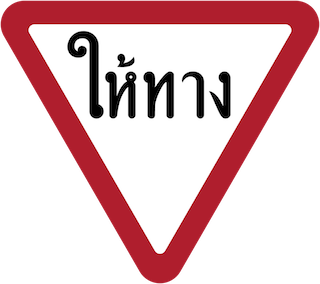
Give way
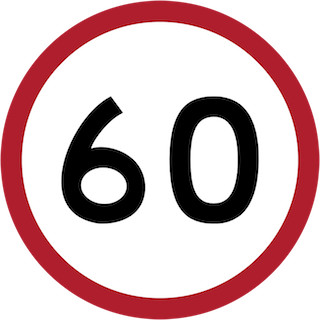
Speed limit
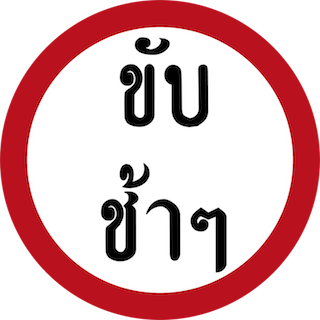
Slow down
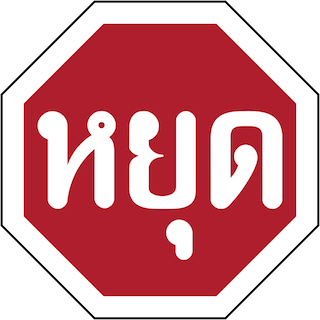
Stop
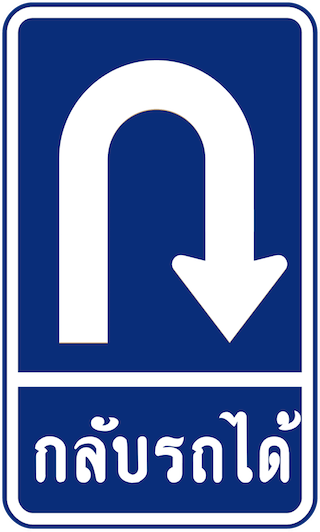
U-turn
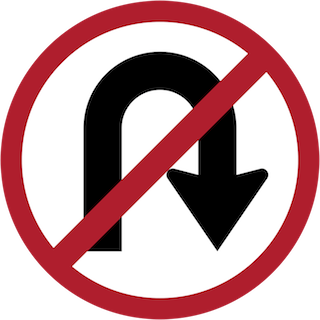
U-turn prohibited
Traffic lights are the same as in the rest of the world - red light means stop, green light means go. It is allowed to turn left on a red light, unless forbidden by a separate sign. Turn like this can be found at Soi 55, for example. If in doubt, just wait for the green light, or people behind you starting to angrily honk their horns at you.
Other traffic
Motorcycles, bicycles and pedestrians
Keep an eye out for these - the standard way of driving a motorcycle is to squeeze yourself and your cycle to every possible and impossible opening. Don’t forget to check your blind spots before changing lanes or taking a turn. The same goes for bicycles.
Because the roads are “little” light on zebra crossings and pedestrian overpasses, people on foot often cross the road in random locations. Watch out for them, especially after dark!
All pedestrians are not human - dogs and other animals might also cross the road, especially at nighttime in the outskirts of town.
Observe the traffic
Always keep an eye on what’s happening around you! Not only for avoiding collisions, but also because seeing what others are doing and how they are driving helps you to get a feel for how you should drive.
Signaling to others
Turn signals are used in the same way as in rest of the world - simply turn your blinker on before you’re going to turn and quickly check that others around you notice. The locals seem to regard that last part as optional, but I don’t recommend you to take the same attitude.
Flashing high-beams is often seen on cars trying to overtake you or coming towards you when you are waiting to turn at crossroads. In some parts of the world, this means “No problem, you go first!”, but not here (as you could probably guess from the context). In fact, the most common meaning is opposite: “Out of the way, I’m going here first!”. In some situations, this is also used to warn oncoming traffic about police ahead.
Honking is used the same way as in other countries - warning other traffic when coming from behind a blind corner, to signal slow traffic in front to get out of the way, and to express frustration.
Miscellaneous risks
Stopped cars
Sometimes, you might notice a car stopped on the road, and not on the side of the road. There could be many reasons for why somebody would do that. From valid reasons like the car suddenly breaking down, to stupid, like thinking the road makes a good backdrop for their cool new Instagram picture*, to downright hostile, like intending to rob anyone who stops.
I’ve been advised by some locals that it’s not a good idea to stop in these situations. But on the other hand, I haven’t heard anyone actually get robbed or worse like this. To play it safe, it’s best not to stop, just slow down enough so you can pass safely. Use your best judgement.
*This is not hyperbole or anything - I have seen this happen.
Keeping the doors locked
Somewhat related to the last point, it is common in Thailand to keep your car doors locked while driving, especially at nighttime. This is, of course, to prevent anyone from getting into your car when you’re stopped.
I’m not so sure how big of a risk this is. While driving, I keep my car doors locked if I remember to lock them. Goes without saying that they’re obviously locked whenever the car is parked.
Driving on the main road
The main road of Hua Hin, Thanon Phet Kasem, is one of Thailand’s major roads. Many of Hua Hin’s landmarks are located along this road, or not very far from it, so you will be driving along this road quite often.
You will find many reckless drivers going at way over the speed limit, slower traffic on the left side of the road, buses and minivans without much concern for other road users and other such things. Don’t let this scare you, though - when you get used to it, it’s not quite as bad as it first seems.
Try to stay in the middle lane if you are driving on the three-lane section of the road, or the left lane in other sections. This allows you to easily change to left or right lane when you need to take a turn, but it also keeps you out of the way of the speeding pick-up trucks and other road hazards. Ignore the previous advice if you are driving a small, slow motorcycle and keep to the left lane, close or even on the shoulder.
U-turns
Major roads in Thailand rely on U-turns to allow drivers to change their direction. These can be scary at first - take your time to get used to them and don’t take unnecessary risks!
Use your turn signal well before changing lane to the rightmost one - check your blind spots and rearview mirrors carefully before changing lanes. Remember that if a car behind you is flashing his headlights, it means that he wants to go first! If it is a big car coming fast, it is better to just let him pass while you slow down slightly.
When the road is clear, change the lane, drive to U-turn lane and keep your right turn signal on. Stop at the end of the lane in a spot where you can see the oncoming traffic as clearly as possible - sometimes this might be difficult if there are other cars blocking your sight.
Once the oncoming traffic has cleared, accelerate smoothly and turn your car around so that you end up in the leftmost lane. Now accelerate to regular speed steadily but swiftly, change the lane if you need to, and congratulations! You just completed your first U-turn!
Navigating the sois
Because the sois tend to be rather narrow, it can be quite difficult to navigate them with a car. You have to keep your car aligned to the road in a way that you leave enough space to the right, so that oncoming cars can pass you, and also on the left, so that you don’t accidentally run over pedestrians, cyclists, motorcycles or food stalls. The latter can be more unpredictable, so try to keep your car more to the right, making room for oncoming cars as necessary.
If in doubt, slow down, let other traffic pass, and continue when the situation clears.
For motorcycles, the sois are not a problem - it is quite easy to ride through the narrow spaces.
Parking
Depending on where you’re going, finding suitable parking for your car can be very easy or nerve-wreckingly frustrating.
The easiest places to park are malls, larger shops and other such places with dedicated parking lots or halls.
Parking elsewhere is allowed in places where the sidewalk is painted in a black-and-white pattern. Conversely, red-and-white pattern forbids parking.
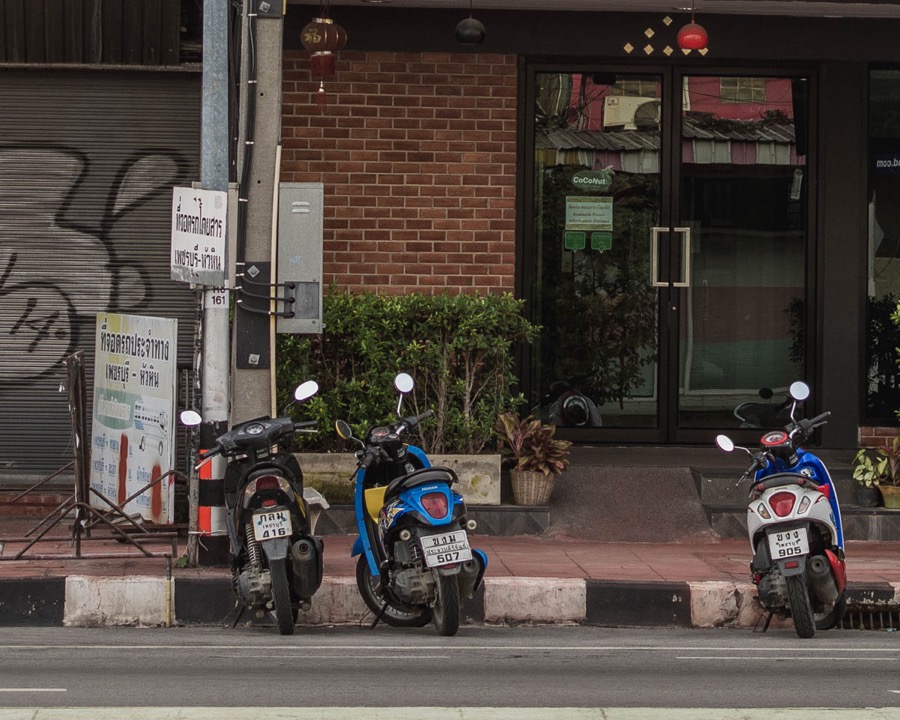
Parking.
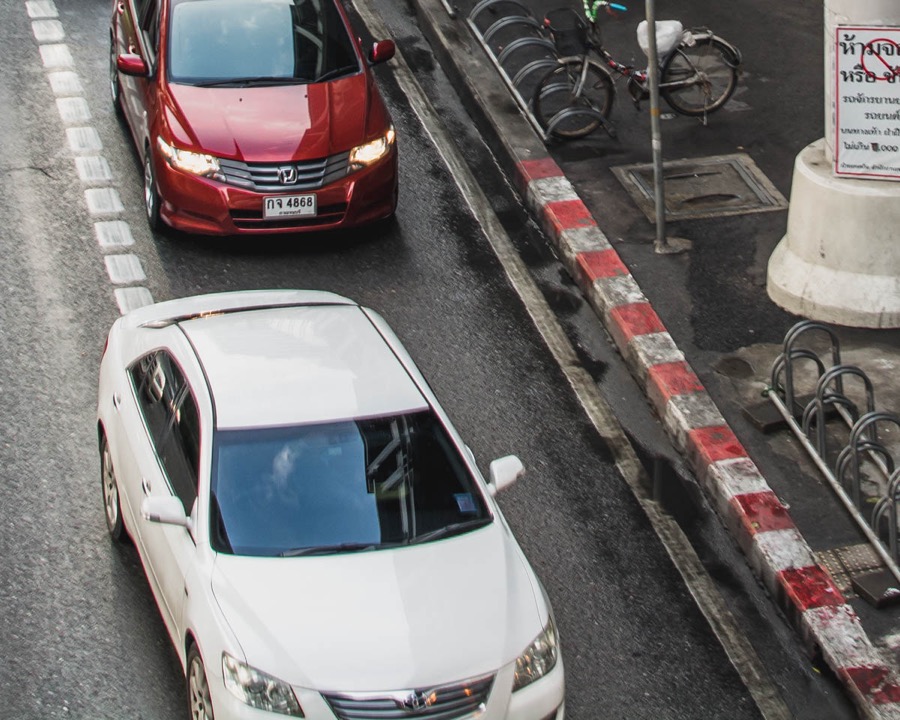
No parking.
Not all sidewalks are marked like this, though - use your best judgement to decide if the place is okay for parking or not.
Also use your common sense when deciding where to park - don’t leave the car in a too quiet place, where it is easy for shady individuals to steal or break into.
Once you’ve found a suitable place, just park your car, close all windows, and remember to lock the doors when leaving.
Extra tip: These are some locations where I have quite often found a convenient or at least not-horrible place to park my car:
- Soi 51
- Naebkehardt Road (turn left or right at the end of Soi 51)
- Along the temple wall near Clock Tower
Important note
Never park your car or motorcycle in the tuk-tuk parking areas near hotels or other such places - the drivers will certainly not take this sort of behaviour kindly! You’ve been warned.
Getting stopped by the police
As a general rule: if you did no wrong, you don’t need to fear the Thai police. Stay polite, answer any questions clearly and the situation will go smoothly.
If the police tell you that you have to pay a fine, it is usually easiest to just pay the 500 - 1000 THB, or whatever is being asked, right away. Say politely that you don’t need any receipt - you’ll save a trip to the police station this way.
Sometimes, especially around the time of national holidays or major events, the police will setup road blocks to inspect vehicles entering the town.
If you happen to run into one of these, simply reduce your speed in advance, stop in the designated area, open your front windows (if in a car), and prepare to show your driver’s licenses (both national and international) if asked. Answer any questions the police may have truthfully. Most likely, you won’t get into any trouble and will be let go in less than a minute.
Getting into an accident
In the unfortunate event that you get into an accident, stay calm and follow these steps:
- Contact authorities. Call the ambulance (1554), the police (191) and the Tourist police (1155) as needed.
- Inform the authorities clearly where the accident happened, how many people are involved, if there’s any injuries and so on. Stay calm and make sure to answer all of the questions before hanging up.
- When help arrives, follow their instructions.
- Once everything is clear, Contact your rental provider and inform them about the damage to your car or motorcycle.
Conclusion
All in all, while Thai traffic can see crazy and even scary at first, it’s not that different from Western traffic once you get used to it.
Driving yourself, you are no longer limited by tuk-tuks and songthaew routes, and you can visit many places that would have been too inconvenient otherwise. Once you get used to it, you’ll never want to go back to relying on public transportation again.